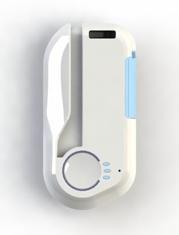Aerte launches revolutionary free-radical based air disinfection device
14 November 2011
Milton Keynes-based disinfection specialists Aerte have launched a revolutionary disinfection device that emits free radicals into a room to neutralise 99.99% of bacteria and viruses in the air.
Aerte's AD 2.0 is specifically designed and proven to continuously eliminate airborne healthcare associated infections (HCAI) in clinical settings — including MRSA, C difficile and Norovirus.
The wall-mounted system can disinfect a room up to a volume of 300m3 and has been proven to not only remove virtually all airborne pathogens but also to target bacteria and viruses present on surfaces (over 20% reduction on most materials). Each unit can be controlled remotely, with automatic notifications alerting staff when the cartridges have run out and on the unit’s current status (eg working, sleeping, off) — making monitoring of this system very easy and largely labour free.
 The
unit (see image on right) is designed to be used with a consumable
cartridge containing a reagent, which is ionised and reacted with
traces of ozone, resulting in the generation of hydroxyl ‘free
radicals’.
The
unit (see image on right) is designed to be used with a consumable
cartridge containing a reagent, which is ionised and reacted with
traces of ozone, resulting in the generation of hydroxyl ‘free
radicals’.
Hydroxyl radicals work by neutralising any dangerous bacteria and viruses, altering their molecular structures so that they become nonviable — neutralising 99.99%. The reason the process is so effective is because hydroxyl radicals are highly reactive molecules missing a hydrogen atom, meaning they can traverse an entire room virtually instantly (in under a second), continuing its search until it encounters a hydrogen atom — forcibly removing it from any organic material and inexorably changing the compounds molecular structure.
Prof. Hugh Pennington, Emeritus Professor of Bacteriology at the University of Aberdeen and an independent advisor to Aerte, said: “Over the last 10 years we have made enormous strides in tackling the spread and prevalence of HCAIs. However, whilst large scale operations and protocols are now in place to ensure the cleanliness of a hospital’s clinical surfaces, no universal strategy has been trialed for the air — leaving it as the last major source of transmission. By using products that eliminate airborne pathogens we will then have a complete solution where all possible causes of transmission have been addressed.”
Javier Segura, CEO of Aerte: “We launched the AD2.0 as we realised there was no ‘active protection’ within healthcare environments from airborne infection - by using free radicals we eliminate pathogens as they appear, vastly reducing the risk or these preventable illnesses.
"The cost of HCAI safety programmes now pay for themselves by reducing the number of bed days and staff sick days, so there is little excuse for airborne transmission routes not being eliminated in the coming years. As pathogens continue to mutate its now not enough for infection control teams to ensure the safety of surfaces — if we want to address the risks of nosocomial infections and increase the safety of hospitals, airborne routes of infection must be also be eliminated.”
Source: Aerte